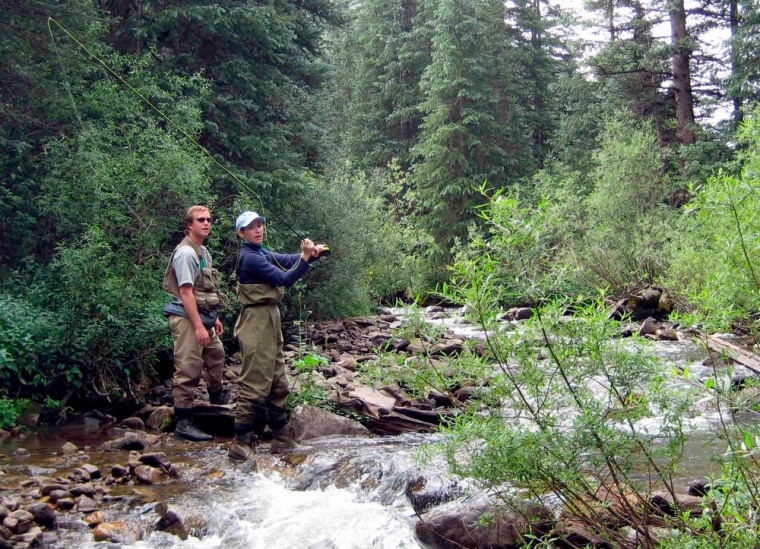An invitation to a wedding in Colorado provided an excuse for a week's vacation exploring mountains and mesas, long-abandoned mining camps and sprawling ranches.
But it was the prospect of fly-fishing that lured me most. The delicate sport was a pastime of my ancestors and one depicted in an embroidered picture that hung for years in my grandparents' living room.
The sport's mystique had grown in my mind from the time I was a teenager, when I was given an amber-colored bamboo fly rod that once belonged to my grandfather. On the brass cap of its aluminum-tube case, he had etched a year: 1930.
Although I had used the rod to learn the basics of casting on my front lawn, I never pursued the sport seriously. So this was an opportunity, after many years, to take a proper crack at it.
My girlfriend and I started early one morning and, with the help of a guide named Henry Jones, sloshed through a rocky stream for half a day, clutching rods that swayed like antennae with every lumbering step. We learned a deceptively simple technique called roll casting, watching Jones and trying to mimic his expert moves.
Jones had driven us to a branch of the Dolores Creek outside Telluride, a small town known mainly for its ski slopes and resorts. He assured us we would reel in fish, even though recent rains had swollen and muddied the waters.
Jones had sized up several gushing sections of the creek before we began, stopping at the roadside, peering from the rolled-down window of his Jeep and making prophetic comments. "I've been fishing since I could walk," he said in a Kentucky drawl.
When we finally settled on a starting point, we pulled over and donned Gore-Tex waders. Jones assembled our rods for us and affixed to our lines the tiny plumed hooks that would be our bait.
We stomped through underbrush before stepping into the water and marching through whooshing rapids, pausing to flick our lines into glassy pools where fish, we were advised, were likely to be lurking.
But the minutes ticked by without a bite. So Jones stopped us and changed our flies, neatly severing our lines and attaching new hooks plucked from the many recesses of his beige vest.
A few minutes later, I tried again, thrusting my elbow downward like an engine's piston — as we'd been taught — and unfurled the line across the surface of the water. And then it happened: the hook, masquerading as a slow-moving insect, vanished with a splash. My heart raced.
"Fish!" Jones shouted.
My line tugged slightly and I began cranking the reel, pulling from the water a small but feisty brook trout. It was a modest catch, to be sure, but one that gave me huge satisfaction.
Fortunately, that was just the beginning. Soon our rods were gently flexing with the weight of more fish, one after another.
Then came the prize catch of the day: a heftier variety of trout known as a cutthroat. It had gobbled my hook and given me a start. Grasping the slippery fish, I posed for the requisite photo before unhooking and releasing it, as we'd done with the others.
The fish we landed were just a sampling of the trout that swim the area's waters. Its main rivers — the Dolores, the San Miguel and the Uncompahgre — are also home to rainbow and brown trout, according to Tom Craddock, co-owner of Telluride Outside, the guide service we used.
Guided trips with Telluride Outside may be expensive for the budget traveler at $280 for two people for a half day or $395 for a full day, but they include ample instruction and the use of high-quality equipment.
The prime season for fly-fishing in the Telluride area runs from July through October, though anglers can fish there year-round. And they may find other reasons to travel there, Craddock said.
"The remoteness and the scenery around here are a huge attraction," he said.
Telluride's reputation as a well-regarded fly-fishing destination has grown partly because, until recently, it was the home of a respected fly rod maker, the Scott Fly Rod Co., said Philip Monahan, editor of the Vermont-based magazine American Angler.
The area also offers "a great system of rivers that have all the things that trout need to survive," including highly oxygenated water and plentiful insects, he said.
And it's a good place for a newcomer to the sport, who should have a good guide and a strong likelihood of success, though it's "tony atmosphere" makes it somewhat costly for the average traveler, he said.
"You go to Telluride, you have a pretty damn good chance of catching a fish," Monahan said.
For me, the trip to Telluride offered more than just a chance to hook fish and gaze at stunning mountain vistas. It also allowed me to follow in the watery footsteps of my forebears, if only for a few hours.
Fly-fishing seems to have run in my family's blood for several generations. My father said my great-grandfather used to practice fly-casting in the front yard of his Philadelphia house while wearing a tweed jacket and vest, even when he was well into his 90s. My grandfather earned a nickname among friends — "Fish Foot" — based on his skills, mainly at other types of fishing.
My great-aunt, according to family lore, used to name her fly-fishing rods. And my father took up rod and reel in his younger days.
The family interest in fishing was apparent to me from an early age. A needlepoint picture of a fly fisherman, stitched by my grandmother, was a familiar sight at my grandparents' house during childhood visits.
It remains to be seen whether I'll continue the family tradition, but for a day in Colorado, I came closer to understanding the sublime pleasure of casting a line across water and hoping for a bite.
